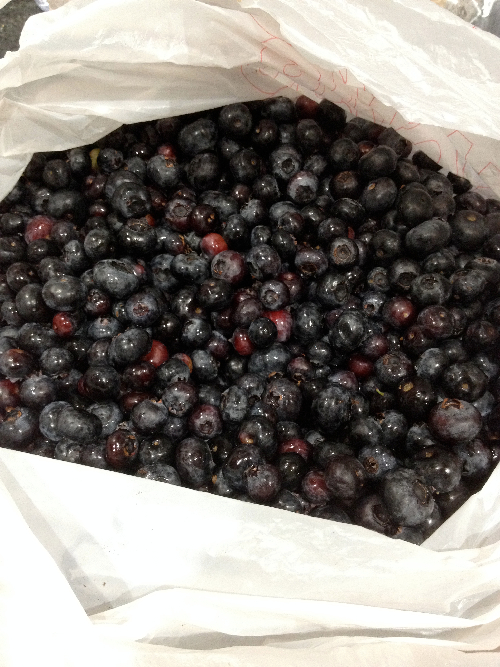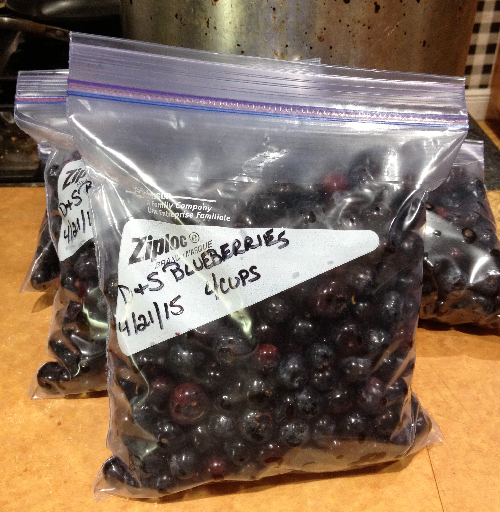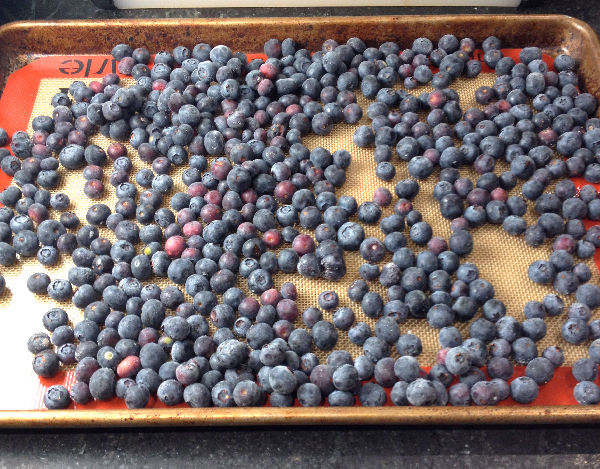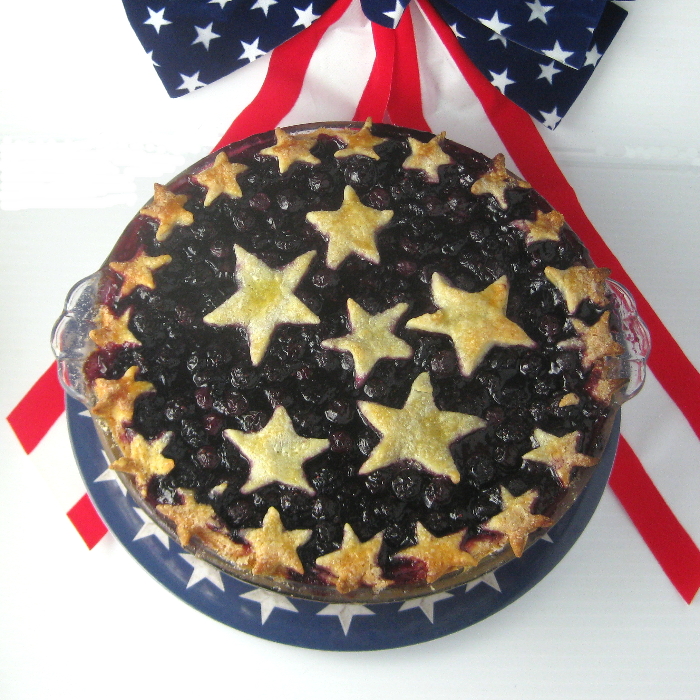This is the first of a series about blueberry farming in Florida, centering around farmer Dan Ebbecke and his D&S Blueberries in Masaryktown, a small farming community in west central Florida. This post was written by Mike J. – otherwise known as “The REAL Flamingo”. Stay tuned for the easiest method of preserving your precious berries for future use – so stock up!
Travel broadens the mind, and I’ve been known to go to great distances to discover the depth and breadth of my ignorance. I don’t have to travel far, however, to reveal how much, as a suburb-dweller, I don’t know about where food comes from and how it got to my plate. Dan Ebbecke’s blueberry farm is a mere 300 miles away— not far at all, really, for a little enlightenment.
So, what’s to know about a blueberry? It’s round. It’s blue. It tastes good. What else do I need to know? (Well, when I’m out in a blueberry field, pail in hand, I really don’t need to know much more, but the same can’t be said for an actual blueberry farmer.) For one thing, a blueberry isn’t just a “blue berry.” There are sharp blues and sunshine blues and even becky blues (lucky girl). There are even emeralds— though they’re blue, as well. There are jewels and Georgia gems, and even farthings (if you like your precious commodities in hard cash). You can even serve windsors; royalty not required. Like mangos, blueberries have countless varieties, and that’s just in Florida. Each is different in one or more ways, and you’d need a hefty scorecard to keep track of them all. A blueberry farmer has to be aware of this vast array; I walk into a market, look into the clamshell package and go “Oh! Blueberries.” I just figured one blueberry was very much the same as another, whether it came from Maine or Florida, Oregon or Timbuktu. Wrong again (but I get that impression a lot when I visit farms.)
Dan’s D&S Farm in Masaryktown is about 40 miles north of the sprawling concrete of Tampa. Its situation— in rolling hills where woods alternate with wide open fields of grazing dairy herds— is about a million light years from there. It would be appropriate (if you bought rural clichés by the pallet-load at a big box store, like I do) to say it’s “bucolic,” “idyllic,” and even “tranquil.” Which it probably is, except for one small (well, maybe huge) problem.
Blueberries have lots of admirers (I know, I’m one), however, not all of those fans are human. Like me, birds know nothing about varieties; to them, blueberries are just round, blue and taste good. On this particular occasion, the birds after Dan’s crop were cedar waxwings. If you ask the Cornell University Ornithology Lab, they’ll tell you that cedar waxwings “love fruit” and “gather by the hundreds to eat berries” either by sitting “in fruiting trees swallowing berries whole, or plucking them in mid-air with a brief fluttering hover.” That may be amazing to watch in your backyard, but it’s ruinous to a farmer if allowed to go on from sun up to sun down in the field. Dan is compelled to do something in this struggle, and what do you need to fight a battle? A gun.
Want to hear a “bird gun”? Crank up the volume and click on this!
Not a real gun, of course. A propane-powered “bird gun”— one that sets off the equivalent of a firecracker every minute or so to scare off the birds. A really LOUD fire cracker; on the order of about 90 decibels even 100 feet away. This is equal to standing a short distance from a revving Harley or having a military jet fly overhead at a thousand feet. Now consider that this is happening about a hundred feet away from your home— which, in Dan’s case, it is— and the “bucolic” and “tranquil” preconceptions of farming life evaporate in a hurry. (Yes, the waxwings retreat; but not very far.)
Now, to anyone who gardens, it’s no secret that whatever you grow is going to have to endure multiple threats. The lesson to me is that, unlike Dan, whatever makes it out of my backyard garden and onto my table is important, but not overwhelmingly vital. If I lose my tomatoes to hornworms, it’s an unfortunate inconvenience. If Dan loses 20 acres of blueberries, it’s a catastrophe. While small private farms have regained their luster as a life-style— dubbed “artisanal” rather than “back-breaking”, when they’re actually both— the reality of farm life is what it’s always been: a lot of labor with no guarantees. Considering the host of perils arrayed against Dan and his blueberries, they’re not just a “blue berry,” they’re darned miracles.
**********
Thanks, Mike!
So, now that you have an idea of the effort that berry farmers go through to grow these jewels for your table, you want to run right out and stock up, right? Well, you’re probably in luck! While Florida’s blueberry season is done for this year, blueberries are in high season in the Carolinas, and moving up to the northeastern states. Prices are at their lowest, so you may be tempted to either find a U-Pick field near you, or even hit up your grocery store to take advantage of the great deals.
But, now that you’ve run amok, what are you going to do with your haul? You may not have the time today to make a lot of jam. Besides, there are so many wonderful uses, other than jam, for blueberries throughout the year. How are you going to preserve them for all your future smoothies, pies, muffins, and more?
The answer, of course, is freezing! It’s easy to do, and fairly quick, and you even have options.
How to Freeze Berries
What you need:
- A rimmed cookie sheet that will fit in your freezer – the larger the pan, the faster this will go
- A clean kitchen towel or silicone baking mat
- A colander
- Good quality quart-size or gallon-size freezer storage bags
- Permanent marker pen
- Blueberries, of course! (Or blackberries, raspberries, mulberries, or strawberries)
- Your freezer
What you need to do:
Place the berries in the colander, a pint (2 standard measuring cups) or 2 pints (4 standard measuring cups) at a time. By the way, a “dry pint” will also measure about 2 standard cups, so you can go by that, if you like. Rinse well under cool water. If preparing strawberries, remove the green hulls and cut the larger berries in half, or even thirds, before rinsing. Allow to drain, giving the colander a little shake.
Write the date and quantity of berries on each freezer bag with the permanent marker.
Line the baking pan with either a clean kitchen towel or the silicone baking mat (I’m telling you, these things are multi-taskers!).
Spread the berries out onto the pan in a single layer, and put the pan into the freezer for about 1 hour.
For strawberries: Remove the pan from the freezer and place the now-frozen berries into a prepared freezer bag. Seal tightly, squeezing out as much air as possible. Flatten the bag a little and place in the freezer for long-term storage.
For the smaller berries: Remove the pan from the freezer and place on your counter top. Run your hand over the now-frozen berries, rubbing them against the towel (or silicone mat), rolling them around. This will remove those annoying little stems that were attached to the berries!
Bag them up in the freezer bag(s), squeezing out as much air as possible, seal and freeze for long-term storage.
If you’re really pressed for time, an alternative method for the smaller berries, only: Rinse the berries in the colander, as noted above, then dump them directly into the freezer storage bag. If you use this method, whenever you’re ready to use them, spread the berries out on the cookie sheet, as specified above, and roll them around to remove any stray stems.
No, you don’t have to add any sugar or other sweeteners, or acid to preserve the berries. They will stay good and vibrant in your freezer for over a year!
Whenever you’re ready to use them in your favorite recipes, just take a bag o’ berries out of the freezer and go. You don’t have to thaw the berries completely before using, in most cases, although you may want to thaw them just a bit (a couple of minutes in the microwave should do), just enough to loosen them up so you can remove them from their bags a bit easier.
Now you’ll be ready to bake or can just about any summer berry recipe whenever the mood strikes you! How about one of these?
Many thanks to Dan Ebbecke for sharing his valuable time and allowing us to pick some luscious blueberries from his field, at no charge. All opinions, recipes, text, and photographs are my own and original to RJ Flamingo and her real-life alter-ego, and are copyrighted materials, not to be reproduced in any form without express permission from the author. Links contained in this post may be affiliate links to my Amazon store. If you start here and buy anything on Amazon, I get a small commission. This does not increase your price, but does help me pay my web host. And buy food. Thank you for your support!












What a great article, Renee. I learned so much. I had no idea there were so many varieties of blueberries. I had no idea there was such a thing as a bird gun (glad to hear it’s not real), and I loved your tip about rolling the frozen blueberries to remove those pesky stems. I feel so much smarter now. Thanks 🙂
Thanks, Renee! I didn’t know about a lot of this stuff, either. That’s why I love taking these “field trips” and speaking with the farmers. It really gives you a different perspective on how our produce gets from farm to table. 🙂
Awesome… I didn’t know that about the bird guns. We pick blueberries in East Texas but the birds don’t bother them…and they don’t have natural enemies here… guess Texas birds have more manners than Florida ones… 😛
The cedar waxwings are actually northern migratory birds, following the food, Marye. It was amazing to see a great cloud of them descend onto a remote part of the field, then retreat when the “bird gun” went off. You can imagine how quickly they could strip the field of berries, if unimpeded!